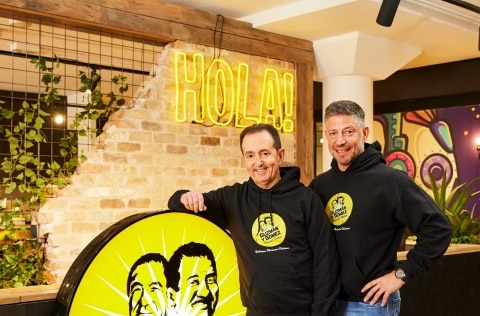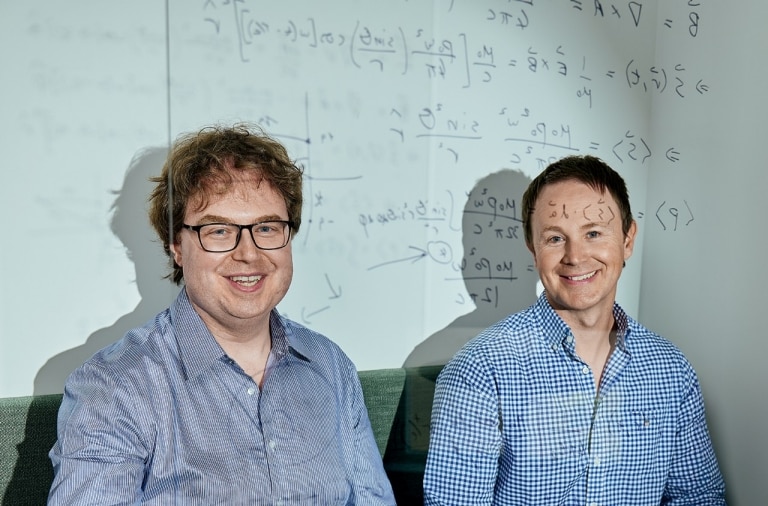Meet the Unconventional Game-Changers in Business
For high-level leaders looking for a competitive advantage in a dramatically altered business landscape, specialist consultants can bring a different and, at times, downright unorthodox point of view.

Inhaling success: Rory Warnock
1/5What: Breathwork specialist
Philosophy: Focusing on breath can change the way you feel and behave.
Conscious breathing or breathwork helped Scottish-born strength and conditioning graduate Rory Warnock to turn his life around.
In 2017, one year into a corporate career in consumer goods sales in London, Warnock was on an active quest to improve his mental health after being prescribed medication for anxiety and depression. Then someone suggested he take a breathwork class. “I thought it sounded ridiculous but I like to keep an open mind.”
The result was a profound experience. “I felt joyful, euphoric, loved, loving, free. I was smiling and crying – and I was hooked,” recalls Warnock, who then set out to research the science of how breath connects with human physiology, in particular the nervous system.
He discovered that the secret to keeping calm or feeling more alive, clear thinking, sharp focus, sleeping soundly and, ultimately, optimal performance and resilience, was literally under his nose. “By breathing in specific rhythms and rates, you can change the way you feel, act and behave.”
Within a year of trying breathwork, Warnock didn’t need antidepressants any longer. And his discovery was uncannily well-timed. When he arrived in Australia in March 2020, a pandemic-induced awareness of mental health was about to unfold. As it turns out, he had the ideal therapy.
Warnock now lives in Bondi and shares his knowledge one-on-one with executives and professionals, runs corporate coaching sessions for small groups or large (sometimes 500 online) and is a soughtafter keynote speaker. Employees at the Australian Securities Exchange, Google, Amazon and Uber, among many others, have learnt the benefits of his conscious breathing techniques.
Stress is the most common reason people check in with him, says Warnock. After all, studies show IQ and decisionmaking slide when we are stressed.
Group sessions often coincide with the need to alleviate year-end pressures, while he works weekly on the stress thresholds of several highly placed Macquarie and Deutsche bankers in individual 90-minute sessions. At law firm Ashurst, Warnock is part of the cognitive performance team.
Far from being a load of hot air, slow, deep breathing can improve both physical and mental health by increasing diaphragm function and oxygen delivery to body tissues. Done right, it changes brainwaves from alpha to beta so you can move into a more creative state of flow, he says. “The beauty of breathwork is that you have access to it 24/7. Once you’ve learnt it, you can do two minutes on the commute, five minutes before a big meeting or pitch and 10 minutes before bed. The benefits are immediate.”
Plus, it’s pretty well risk-free. You can breathe dysfunctionally, though. Short, shallow, audible breaths through the mouth into the upper chest translate into less oxygen for your tissues and can also change your facial structure, he warns.
Recently, Warnock completed his first ultramarathon and has clocked up 100 kilometres through the Blue Mountains, west of Sydney, and 200 kilometres in Chile’s Atacama Desert. He’s also won a 45-kilometre race around the Snowy Mountains’ Lake Crackenback, in four hours and six minutes. His hidden advantage? Nasal breathing.
Image credit: Paul Harris
Mastering the mindset: Ben Crowe
2/5What: Mindset coach
Philosophy: Understand your own motivations first
Ask Ben Crowe about his point of difference in the executive coaching space and he looks confused. “I don’t know. I don’t come from an executive coaching background and I don’t know the difference between a coach and a mentor.”
That said, the former global sports marketing director at Nike has earned such a good reputation worldwide as the mindset coach to executives and sports stars, including Ash Barty, Stephanie Gilmour and Dylan Alcott, there’s a queue of 1000-plus people seeking his services. Many more if you count those who sign up for his Mojo Mindset course online.
What’s the excitement about? A sprint through his background shows embryonic ideas for Crowe began as he managed the careers of big-name athletes in the United States 25 years ago and saw the impact of fame and athletic success (extrinsic goals) on young lives that often went off the rails. What dawned on him was the importance for everyone to understand their intrinsic motivations first and that notion underpins his philosophy today.
“Nike’s competitive advantage was storytelling – just do it, live strong. To be a good storyteller, you need to know your own story first. Most athletes don’t. Most of us don’t. That took me on a journey about authenticity, vulnerability as a strength and connecting with yourself before you connect with the outside world.”
Crowe’s message is like a mantra. “You need to be a human being before you can be a human doing.” It’s a concept he delivered when he returned to Australia after the 2000 Olympics and set up a management consultancy, working with CEOs and others who often asked for personal leadership guidance.
While the essence of his core message is more nuanced, it carried through when he worked with the Richmond Football Club in 2016 and the Australian cricket team in the wake of its notorious “sandpapergate” ball-tampering scandal in 2018. It helped Ash Barty to achieve her greatest extrinsic goal, winning the Australian Open, before retiring with her sights on more important intrinsic life matters.
The big five extrinsic motivations that sabotage us all, says Crowe, are money, materialism, corporate or career status, social status and craving recognition from others – “obsessing and caring what they think about me rather than what I think about myself”. The great universal underminer is FOPO – fear of other people’s opinions.
Most of his clients are trying to figure out what they want out of life or leadership. “Everyone in the world is looking for the same two things – confidence and happiness.” His advice is to steadfastly focus on what we can control.
“When we redefine success from an intrinsic point of view, we can still chase extrinsic goals. We just don’t want to define success by whether we get there or not. Enjoy the process. That way we don’t have to wait to be successful or happy.”
Finding an edge with empathy: Dr Kirstin Ferguson
3/5What: Leadership expert
Philosophy: Know when to open your heart at work
The idea of leaders applying emotional intelligence (EI) and empathy is not new but Dr Kirstin Ferguson, researcher and non-executive director at PEXA and Envato, captured a moment in time with her second book, Head & Heart: The Art of Modern Leadership.
While American psychologist Daniel Goleman highlighted the power of EI more than 25 years ago, Head & Heart debuted in the top 10 of Australian non-fiction books in January. Since then Ferguson’s been on the world stage with top business thinkers Jim Collins and Adam Grant. And she’s just sold the English language global rights to United States publisher Berrett- Koehler, with a September launch planned.
How did she capture the zeitgeist? Did COVID convince leaders to wear their hearts on their sleeves? Certainly, the pandemic brought heart-based skills to the fore. “Leaders used to think of their teams as one collective – you fitted in or you didn’t,” she says. Now there’s an expectation, generationally and post- COVID, to consider individuals and the best way to lead that person. “It takes far more work and many leaders are feeling lost,” says Ferguson, who metes out her leadership smarts one-on-one to just a few CEOs of large organisations these days.
The catalyst for her recent success, she says, is in coalescing a range of hard tomaster topics for leaders, from humility and self-awareness to courage and empathy – the heart skills that come with subsets of psychological safety and vulnerability. She topped those with fresh research that defined head and heart qualities and showed her clients the way forward.
The modern leader, such as former New Zealand Prime Minister Jacinda Ardern, Ukraine President Volodymyr Zelenskyy and Microsoft CEO Satya Nadella, knows they need to lead with both their head and their heart but it’s a fine calibration, explains Ferguson.
“A lot of leaders find it difficult to allow empathy out. These are not soft skills. It’s comparatively easy to lead with your head – that’s what we’ve been rewarded for in our jobs. Most of us are pretty good at it.”
But, she says, “to be a humble leader, to be self-aware of the impact you’re having on others, to be courageous and stand up for what you believe in, even in the face of pressure not to – unless you’re a confident leader, it can be quite terrifying.”
Ferguson helps leaders to unlock what it means to lead with the heart. “We work on scenarios or they talk about upcoming events.” A common area is overcoming their fear of not knowing all the answers and asking others for their ideas.
“If you can find the confidence and courage and know when to lead with your heart, you’ll be a much better leader in all aspects of your life. It takes some reassurance. It takes a workplace that rewards that kind of leadership as well.” Increasingly, she believes it is the future of leadership.
The new balance: Andrew May
4/5What: Transformation specialist
Philosophy: Increasing leadership capacity requires mastering the brain and body.
The most intriguing aspect of Andrew May’s coaching philosophy is that he debunks the concept of work-life balance. “It’s a crock of garbage – it sets people up for failure,” insists the former exercise physiologist who counts Commonwealth Bank chief Matt Comyn, IAG CEO Nick Hawkins and Compass Group chief commercial officer Shelley Roberts among his many clients. “If you’re the CEO of a publicly listed company, a startup or an entrepreneur and you want balance – wrong job! You need to be prepared for the trade-off.”
May teaches people “how to work really hard for periods and how to down-regulate, control the inner dialogue and set up frameworks so they don’t end up burnt out, divorced and their kids hating them in 10 years time”.
Leadership capacity is May’s specialty. That involves helping clients to establish sustainable operating rhythms that factor in peak work demands, such as intense quarterly reporting periods, and relaxing school holidays. Essential to the process is protecting time, boosting energy and powering up the ability to focus attention. There’s a strong physical backbone to his work. He calls it “hard fun”.
His unconventional “inside out” approach makes executives “match fit” to run the business. It leans into the 1970s biopsychosocial model created by psychiatrist Dr George L. Engel, which explores the links between physiological and psychological pathways and socioenvironmental factors (think culture and relationships). May mixes in personal experience from his 25 years in sport, a stint in a professional services firm, a marriage break-up when his children were young, bouts with cancer and near-bankruptcy.
Clients, who pay him $15,000 for a two-to-three-month period, tend to be well-informed super-performers or those with a “Bunsen burner on their backside” because they have just been promoted or are about to take on a new role. Either way, they need to be ready for May’s rigour, which starts with a thorough analysis.
Working with stress and resilience researcher Dr Tom Buckley at Sydney University, May gives his clients swathes of metrics and KPIs on their body, drawn from wearable tech – each person is required to wear a heart monitor for 48 hours – and blood tests. “From the tech we can see how much of their day is spent in stress or the sympathetic nervous system, how well they sleep and their biological age. Our goal is for clients to be five years younger biologically, to give them the capacity to run at a high level.”
What follows is a prescribed exercise and dietary program – cutting out sugar, alcohol in moderation and eating the right macronutrients – with monitoring via a dashboard, then a mix of mental skills and energy management training.
If the going gets too tough, there’s an exit strategy. May and his clients agree at the outset that they can sack each other. But many of them have stuck with him long-term. “Life changes – you might land a global role and need to learn about your body clock and the suprachiasmatic nucleus [the region of the brain that regulates most circadian rhythms in the body],” he says. “It’s not like you get all this info and suddenly you’re ‘performed’.”














